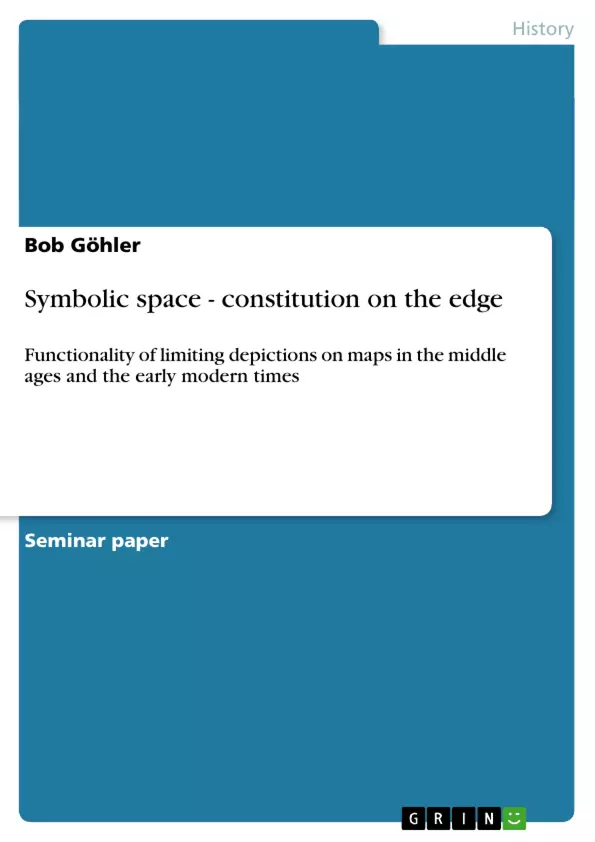Not only since the initiation of cartography-history medieval maps and those of the early modern times impressed but also bothered modern viewers. It is evident that in any map the world is presented as flat. This fact resulted in the assumption, medieval human beeings considered the world as a flat disc. It is remarkable that there seems to be a development of mapping, changing through differing concepts and differing utilization of maps in various fields. This change of different natures of depictions of the world was over years used by generations of scientists to postulate a successive development from somehow religious maps (like the Hereford-map, the Ebstorf-map and other medieval T-O-maps) to those scientific maps like the Waldseemüller-map or other later maps. It is promising to recontextualise the T-O-Maps and understand them as a kind of “geography of meaning”. Following this approach means taking a closer look at the maps and trying to find out what kind of world is depicted there, what exactly is represented and, in a matter of space perception as this essays questioning demands, what spaces are depicted and how they are delimited. Upon this closer examination a methodological closer consideration of the use of the maps and its rules and conditions is indispensable. Maybe a differentiation between depicted world models, as the considered period covers howbeit the birth of measuring geography, results in a distinction of differing depicted spaces. This way possibly the edge-phenomena variations like monsters, cosmological signs and other symbols taken out of a rich knowledge-reservoir you may find in medieval as well as in early modern mapping, can maybe enlight the idea of the space that they are delimiting. In case of imposing restrictions on the topic, the following thoughts are based on single case studies of maps with differing edge-depicting practice between 1200 and 1760.
Inhaltsverzeichnis (Table of Contents)
- Introduction
- Medieval Mappae Mundi - Ebstorf and Hereford
- Simultaneity of the Non-Simultaneous
- Facing the Unknown - Monster-Galleries
- Early Modern Time Cartography
- The Map that Named America
- Two Maps of a Very Later Period
- Conclusions and Prospects
Zielsetzung und Themenschwerpunkte (Objectives and Key Themes)
This work aims to analyze the functionality of limiting depictions on maps from the Middle Ages to the early modern period. It explores how these depictions, often featuring monsters and other symbolic elements, contributed to the constitution of symbolic space and the understanding of the world at the time. The key themes include:- The evolution of mapmaking practices from medieval T-O-maps to early modern measuring maps.
- The significance of symbolic elements, such as monsters and cosmological signs, in defining and delimiting space on maps.
- The role of maps as "geography of meaning" and their function in transmitting knowledge and understanding of the world.
- The concept of "simultaneity of the non-simultaneous" in the portrayal of salvation history on medieval maps.
- The influence of religious perspectives on cartography and the construction of spatial representation.
Zusammenfassung der Kapitel (Chapter Summaries)
- Introduction: This chapter introduces the topic of medieval and early modern maps, highlighting the differences between traditional T-O-maps and more scientific measuring maps. It emphasizes the importance of studying maps as "geography of meaning" rather than simply as geographic representations.
- Medieval Mappae Mundi - Ebstorf and Hereford: This chapter focuses on two specific medieval maps, the Ebstorf-map and the Hereford-map. It explores their common features, including their easterly alignment, their representation of Jerusalem as the center of the world, and their inclusion of salvation history depictions. The chapter also introduces the concept of "simultaneity of the non-simultaneous" which refers to the depiction of multiple events from salvation history on these maps.
Schlüsselwörter (Keywords)
This work centers on the analysis of medieval and early modern maps, emphasizing their role in shaping spatial understanding and symbolic space. Key terms include: mappae mundi, T-O-maps, symbolic space, limiting depictions, monsters, cosmological signs, geography of meaning, salvation history, simultaneity of the non-simultaneous, Ebstorf-map, Hereford-map, Martin Waldseemüller, early modern cartography.- Citation du texte
- Bob Göhler (Auteur), 2008, Symbolic space - constitution on the edge, Munich, GRIN Verlag, https://www.grin.com/document/117803



